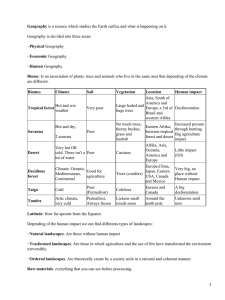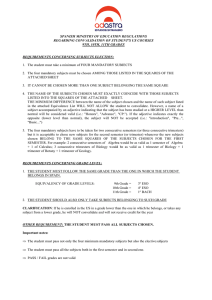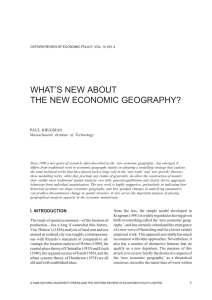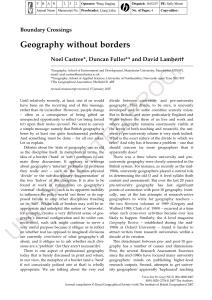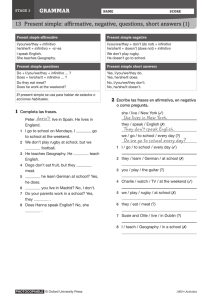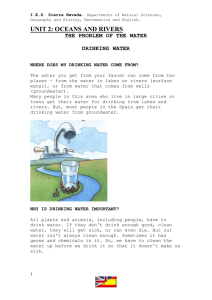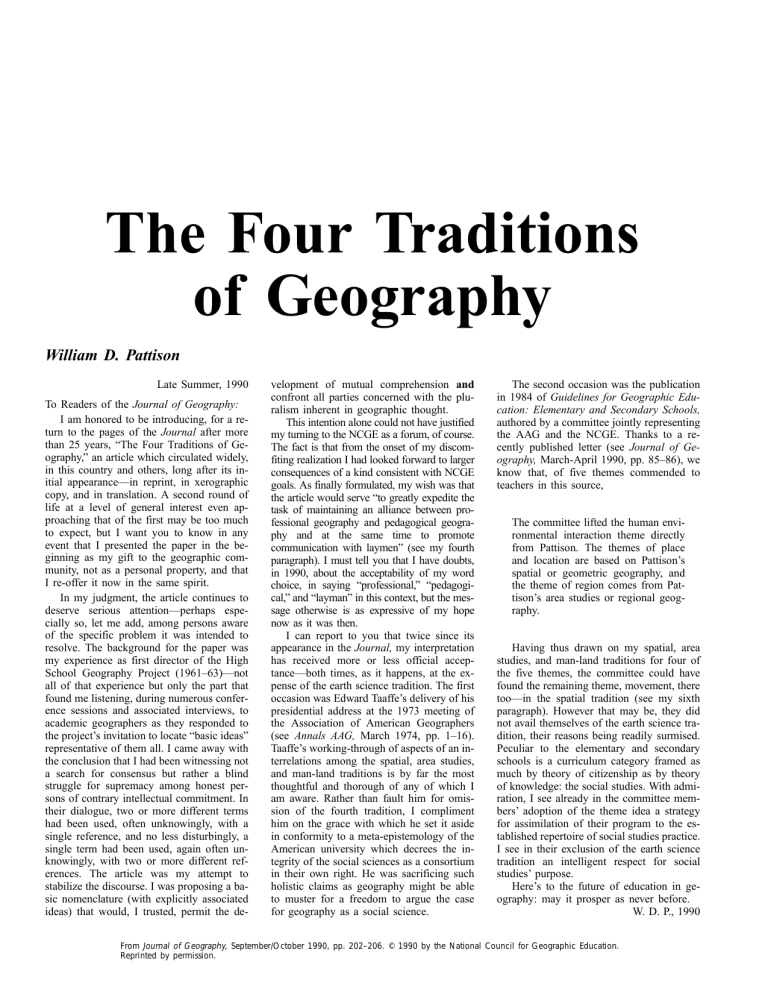
The Four Traditions of Geography William D. Pattison Late Summer, 1990 To Readers of the Journal of Geography: I am honored to be introducing, for a return to the pages of the Journal after more than 25 years, “The Four Traditions of Geography,” an article which circulated widely, in this country and others, long after its initial appearance—in reprint, in xerographic copy, and in translation. A second round of life at a level of general interest even approaching that of the first may be too much to expect, but I want you to know in any event that I presented the paper in the beginning as my gift to the geographic community, not as a personal property, and that I re-offer it now in the same spirit. In my judgment, the article continues to deserve serious attention—perhaps especially so, let me add, among persons aware of the specific problem it was intended to resolve. The background for the paper was my experience as first director of the High School Geography Project (1961–63)—not all of that experience but only the part that found me listening, during numerous conference sessions and associated interviews, to academic geographers as they responded to the project’s invitation to locate “basic ideas” representative of them all. I came away with the conclusion that I had been witnessing not a search for consensus but rather a blind struggle for supremacy among honest persons of contrary intellectual commitment. In their dialogue, two or more different terms had been used, often unknowingly, with a single reference, and no less disturbingly, a single term had been used, again often unknowingly, with two or more different references. The article was my attempt to stabilize the discourse. I was proposing a basic nomenclature (with explicitly associated ideas) that would, I trusted, permit the de- velopment of mutual comprehension and confront all parties concerned with the pluralism inherent in geographic thought. This intention alone could not have justified my turning to the NCGE as a forum, of course. The fact is that from the onset of my discomfiting realization I had looked forward to larger consequences of a kind consistent with NCGE goals. As finally formulated, my wish was that the article would serve “to greatly expedite the task of maintaining an alliance between professional geography and pedagogical geography and at the same time to promote communication with laymen” (see my fourth paragraph). I must tell you that I have doubts, in 1990, about the acceptability of my word choice, in saying “professional,” “pedagogical,” and “layman” in this context, but the message otherwise is as expressive of my hope now as it was then. I can report to you that twice since its appearance in the Journal, my interpretation has received more or less official acceptance—both times, as it happens, at the expense of the earth science tradition. The first occasion was Edward Taaffe’s delivery of his presidential address at the 1973 meeting of the Association of American Geographers (see Annals AAG, March 1974, pp. 1–16). Taaffe’s working-through of aspects of an interrelations among the spatial, area studies, and man-land traditions is by far the most thoughtful and thorough of any of which I am aware. Rather than fault him for omission of the fourth tradition, I compliment him on the grace with which he set it aside in conformity to a meta-epistemology of the American university which decrees the integrity of the social sciences as a consortium in their own right. He was sacrificing such holistic claims as geography might be able to muster for a freedom to argue the case for geography as a social science. The second occasion was the publication in 1984 of Guidelines for Geographic Education: Elementary and Secondary Schools, authored by a committee jointly representing the AAG and the NCGE. Thanks to a recently published letter (see Journal of Geography, March-April 1990, pp. 85–86), we know that, of five themes commended to teachers in this source, The committee lifted the human environmental interaction theme directly from Pattison. The themes of place and location are based on Pattison’s spatial or geometric geography, and the theme of region comes from Pattison’s area studies or regional geography. Having thus drawn on my spatial, area studies, and man-land traditions for four of the five themes, the committee could have found the remaining theme, movement, there too—in the spatial tradition (see my sixth paragraph). However that may be, they did not avail themselves of the earth science tradition, their reasons being readily surmised. Peculiar to the elementary and secondary schools is a curriculum category framed as much by theory of citizenship as by theory of knowledge: the social studies. With admiration, I see already in the committee members’ adoption of the theme idea a strategy for assimilation of their program to the established repertoire of social studies practice. I see in their exclusion of the earth science tradition an intelligent respect for social studies’ purpose. Here’s to the future of education in geography: may it prosper as never before. W. D. P., 1990 From Journal of Geography, September/October 1990, pp. 202–206. © 1990 by the National Council for Geographic Education. Reprinted by permission. Reprinted from the Journal of Geography, 1964, pp. 211–216. In 1905, one year after professional geography in this country achieved full social identity through the founding of the Association of American Geographers, William Morris Davis responded to a familiar suspicion that geography is simply an undisciplined “omnium-gatherum” by describing an approach that as he saw it imparts a “geographical quality” to some knowledge and accounts for the absence of the quality elsewhere.1 Davis spoke as president of the AAG. He set an example that was followed by more than one president of that organization. An enduring official concern led the AAG to publish, in 1939 and in 1959, monographs exclusively devoted to a critical review of definitions and their implications.2 Every one of the well-known definitions of geography advanced since the founding of the AAG has had its measure of success. Tending to displace one another by turns, each definition has said something true of geography.3 But from the vantage point of 1964, one can see that each one has also failed. All of them adopted in one way or another a monistic view, a singleness of preference, certain to omit if not to alienate numerous professionals who were in good conscience continuing to participate creatively in the broad geographic enterprise. The thesis of the present paper is that the work of American geographers, although not conforming to the restrictions implied by any one of these definitions, has exhibited a broad consistency, and that this essential unity has been attributable to a small number of distinct but affiliated traditions, operant as binders in the minds of members of the profession. These traditions are all of great age and have passed into American geography as parts of a general legacy of Western thought. They are shared today by geographers of other nations. There are four traditions whose identification provides an alternative to the competing monistic definitions that have been the geographer’s lot. The resulting pluralistic basis for judgment promises, by full accommodation of what geographers do and by plain-spoken representation thereof, to greatly expedite the task of maintaining an alliance between professional geography and pedagogical geography and at the same time to promote communication with laymen. The following discussion treats the traditions in this order: (1) a spatial tradition, (2) an area studies tradition, (3) a man-land tradition and (4) an earth science tradition. Spatial Tradition Entrenched in Western thought is a belief in the importance of spatial analysis, of the act of separating from the happenings of expe- rience such aspects as distance, form, direction and position. It was not until the 17th century that philosophers concentrated attention on these aspects by asking whether or not they were properties of things-in-themselves. Later, when the 18th century writings of Immanuel Kant had become generally circulated, the notion of space as a category including all of these aspects came into widespread use. However, it is evident that particular spatial questions were the subject of highly organized answering attempts long before the time of any of these cogitations. To confirm this point, one need only be reminded of the compilation of elaborate records concerning the location of things in ancient Greece. These were records of sailing distances, of coastlines and of landmarks that grew until they formed the raw material for the great Geographia of Claudius Ptolemy in the 2nd century A.D. A review of American professional geography from the time of its formal organization shows that the spatial tradition of thought had made a deep penetration from the very beginning. For Davis, for Henry Gannett and for most if not all of the 44 other men of the original AAG, the determination and display of spatial aspects of reality through mapping were of undoubted importance, whether contemporary definitions of geography happened to acknowledge this fact or not. One can go further and, by probing beneath the art of mapping, recognize in the behavior of geographers of that time an active interest in the true essentials of the spatial tradition—geometry and movement. One can trace a basic favoring of movement as a subject of study from the turn-of-the-century work of Emory R. Johnson, writing as professor of transportation at the University of Pennsylvania, through the highly influential theoretical and substantive work of Edward L. Ullman during the past 20 years and thence to an article by a younger geographer on railroad freight traffic in the U.S. and Canada in the Annals of the AAG for September 1963.4 One can trace a deep attachment to geometry, or positioning-and-layout, from articles on boundaries and population densities in early 20th century volumes of the Bulletin of the American Geographical Society, through a controversial pronouncement by Joseph Schaefer in 1953 that granted geographical legitimacy only to studies of spatial patterns5 and so onward to a recent Annals report on electronic scanning of cropland patterns in Pennsylvania.6 One might inquire, is discussion of the spatial tradition, after the manner of the remarks just made, likely to bring people within geography closer to an understanding of one another and people outside geography closer to an understanding of geographers? There seem to be at least two reasons for being hopeful. First, an appreciation of this tradition allows one to see a bond of fellowship uniting the elementary school teacher, who attempts the most rudimentary instruction in directions and mapping, with the contemporary research geographer, who dedicates himself to an exploration of central-place theory. One cannot only open the eyes of many teachers to the potentialities of their own instruction, through proper exposition of the spatial tradition, but one can also “hang a bell” on research quantifiers in geography, who are often thought to have wandered so far in their intellectual adventures as to have become lost from the rest. Looking outside geography, one may anticipate benefits from the readiness of countless persons to associate the name “geography” with maps. Latent within this readiness is a willingness to recognize as geography, too, what maps are about—and that is the geometry of and the movement of what is mapped. Area Studies Tradition The area studies tradition, like the spatial tradition, is quite strikingly represented in classical antiquity by a practitioner to whose surviving work we can point. He is Strabo, celebrated for his Geography which is a massive production addressed to the statesmen of Augustan Rome and intended to sum up and regularize knowledge not of the location of places and associated cartographic facts, as in the somewhat later case of Ptolemy, but of the nature of places, their character and their differentiation. Strabo exhibits interesting attributes of the area-studies tradition that can hardly be overemphasized. They are a pronounced tendency toward subscription primarily to literary standards, an almost omnivorous appetite for information and a self-conscious companionship with history. It is an extreme good fortune to have in the ranks of modern American geography the scholar Richard Hartshorne, who has pondered the meaning of the area-studies tradition with a legal acuteness that few persons would challenge. In his Nature of Geography, his 1939 monograph already cited,7 he scrutinizes exhaustively the implications of the “interesting attributes” identified in connection with Strabo, even though his concern is with quite other and much later authors, largely German. The major literary problem of unities or wholes he considers from every angle. The Gargantuan appetite for miscellaneous information he accepts and rationalizes. The companionship between area studies and history he clarifies by appraising the so-called idiographic con- tent of both and by affirming the tie of both to what he and Sauer have called “naively given reality.” The area-studies tradition (otherwise known as the chorographic tradition) tended to be excluded from early American professional geography. Today it is beset by certain champions of the spatial tradition who would have one believe that somehow the area-studies way of organizing knowledge is only a subdepartment of spatialism. Still, area-studies as a method of presentation lives and prospers in its own right. One can turn today for reassurance on this score to practically any issue of the Geographical Review, just as earlier readers could turn at the opening of the century to that magazine’s forerunner. What is gained by singling out this tradition? It helps toward restoring the faith of many teachers who, being accustomed to administering learning in the area-studies style, have begun to wonder if by doing so they really were keeping in touch with professional geography. (Their doubts are owed all too much to the obscuring effect of technical words attributable to the very professionals who have been intent, ironically, upon protecting that tradition.) Among persons outside the classroom the geographer stands to gain greatly in intelligibility. The title “areastudies” itself carries an understood message in the United States today wherever there is contact with the usages of the academic community. The purpose of characterizing a place, be it neighborhood or nation-state, is readily grasped. Furthermore, recognition of the right of a geographer to be unspecialized may be expected to be forthcoming from people generally, if application for such recognition is made on the merits of this tradition, explicitly. Man-Land Tradition That geographers are much given to exploring man-land questions is especially evident to anyone who examines geographic output, not only in this country but also abroad. O. H. K. Spate, taking an international view, has felt justified by his observations in nominating as the most significant ancient precursor of today’s geography neither Ptolemy nor Strabo nor writers typified in their outlook by the geographies of either of these two men, but rather Hippocrates, Greek physician of the 5th century B.C. who left to posterity an extended essay, On Airs, Waters and Places.8 In this work made up of reflections on human health and conditions of external nature, the questions asked are such as to confine thought almost altogether to presumed influence passing from the latter to the former, questions largely about the effects of winds, drinking water and seasonal changes upon man. Understandable though this uni-directional concern may have been for Hippocrates as medical commentator, and defensible as may be the attraction that this same approach held for students of the condition of man for many, many centuries thereafter, one can only regret that this narrowed version of the man-land tradition, combining all too easily with social Darwinism of the late 19th century, practically overpowered American professional geography in the first generation of its history.9 The premises of this version governed scores of studies by American geographers in interpreting the rise and fall of nations, the strategy of battles and the construction of public improvements. Eventually this special bias, known as environmentalism, came to be confused with the whole of the man-land tradition in the minds of many people. One can see now, looking back to the years after the ascendancy of environmentalism, that although the spatial tradition was asserting itself with varying degrees of forwardness, and that although the area-studies tradition was also making itself felt, perhaps the most interesting chapters in the story of American professional geography were being written by academicians who were reacting against environmentalism while deliberately remaining within the broad man-land tradition. The rise of culture historians during the last 30 years has meant the dropping of a curtain of culture between land and man, through which it is asserted all influence must pass. Furthermore work of both culture historians and other geographers has exhibited a reversal of the direction of the effects in Hippocrates, man appearing as an independent agent, and the land as a sufferer from action. This trend as presented in published research has reached a high point in the collection of papers titled Man’s Role in Changing the Face of the Earth. Finally, books and articles can be called to mind that have addressed themselves to the most difficult task of all, a balanced tracing out of interaction between man and environment. Some chapters in the book mentioned above undertake just this. In fact the separateness of this approach is discerned only with difficulty in many places; however, its significance as a general research design that rises above environmentalism, while refusing to abandon the man-land tradition, cannot be mistaken. The NCGE seems to have associated itself with the man-land tradition, from the time of founding to the present day, more than with any other tradition, although all four of the traditions are amply represented in its official magazine, The Journal of Geography and in the proceedings of its annual meetings. This apparent preference on the part of the NCGE members for defining geography in terms of the man-land tradition is strong evidence of the appeal that manland ideas, separately stated, have for persons whose main job is teaching. It should be noted, too, that this inclination reflects a proven acceptance by the general public of learning that centers on resource use and conservation. Earth Science Tradition The earth science tradition, embracing study of the earth, the waters of the earth, the atmosphere surrounding the earth and the association between earth and sun, confronts one with a paradox. On the one hand one is assured by professional geographers that their participation in this tradition has declined precipitously in the course of the past few decades, while on the other one knows that college departments of geography across the nation rely substantially, for justification of their role in general education, upon curricular content springing directly from this tradition. From all the reasons that combine to account for this state of affairs, one may, by selecting only two, go far toward achieving an understanding of this tradition. First, there is the fact that American college geography, growing out of departments of geology in many crucial instances, was at one time greatly overweighted in favor of earth science, thus rendering the field unusually liable to a sense of loss as better balance came into being. (This one-time disproportion found reciprocate support for many years in the narrowed, environmentalistic interpretation of the man-land tradition.) Second, here alone in earth science does one encounter subject matter in the normal sense of the term as one reviews geographic traditions. The spatial tradition abstracts certain aspects of reality; area studies is distinguished by a point of view; the man-land tradition dwells upon relationships; but earth science is identifiable through concrete objects. Historians, sociologists and other academicians tend not only to accept but also to ask for help from this part of geography. They readily appreciate earth science as something physically associated with their subjects of study, yet generally beyond their competence to treat. From this appreciation comes strength for geography-as-earth-science in the curriculum. Only by granting full stature to the earth science tradition can one make sense out of the oft-repeated addage, “Geography is the mother of sciences.” This is the tradition that emerged in ancient Greece, most clearly in the work of Aristotle, as a wide-ranging study of natural processes in and near the surface of the earth. This is the tradition that was rejuvenated by Varenius in the 17th century as “Geographia Generalis.” This is the tradition that has been subjected to subdivision as the development of science has approached the present day, yielding mineralogy, paleontology, glaciology, meterology and other specialized fields of learning. Readers who are acquainted with American junior high schools may want to make a challenge at this point, being aware that a current revival of earth sciences is being sponsored in those schools by the field of geology. Belatedly, geography has joined in support of this revival.10 It may be said that in this connection and in others, American professional geography may have faltered in its adherence to the earth science tradition but not given it up. In describing geography, there would appear to be some advantages attached to isolating this final tradition. Separation improves the geographer’s chances of successfully explaining to educators why geography has extreme difficulty in accommodating itself to social studies programs. Again, separate attention allows one to make understanding contact with members of the American public for whom surrounding nature is known as the geographic environment. And finally, specific reference to the geographer’s earth science tradition brings into the open the basis of what is, almost without a doubt, morally the most significant concept in the entire geographic heritage, that of the earth as a unity, the single common habitat of man. dent, is the fourth tradition prosecuted under constraints from the first and second traditions. Going further, one can uncover the meanings of “systematic geography,” “regional geography,” “urban geography,” “industrial geography,” etc. It is to be hoped that through a widened willingness to conceive of and discuss the field in terms of these traditions, geography will be better able to secure the inner unity and outer intelligibility to which reference was made at the opening of this paper, and that thereby the effectiveness of geography’s contribution to American education and to the general American welfare will be appreciably increased. An Overview The four traditions though distinct in logic are joined in action. One can say of geography that it pursues concurrently all four of them. Taking the traditions in varying combinations, the geographer can explain the conventional divisions of the field. Human or cultural geography turns out to consist of the first three traditions applied to human societies; physical geography, it becomes evi- 1. William Morris Davis, “An Inductive Study of the Content of Geography,” Bulletin of the American Geographical Society, Vol. 38, No. 1 (1906), 71. 2. Richard Hartshorne, The Nature of Geography, Association of American Geographers (1939), and idem., Perspective on the Nature of Geography, Association of American Geographers (1959). 3. The essentials of several of these definitions appear in Barry N. Floyd, “Putting Geography Notes in Its Place,” The Journal of Geography, Vol. 62, No. 3 (March, 1963). 117–120. 4. William H. Wallace, “Freight Traffic Functions of Anglo-American Railroads,” Annals of the Association of American Geographers, Vol. 53, No. 3 (September, 1963), 312–331. 5. Fred K. Schaefer, “Exceptionalism in Geography: A Methodological Examination,” Annals of the Association of American Geographers, Vol. 43, No. 3 (September, 1953), 226–249. 6. James P. Latham, “Methodology for an Instrumental Geographic Analysis,” Annals of the Association of American Geographers, Vol. 53, No. 2 (June, 1963), 194–209. 7. Hartshorne’s 1959 monograph, Perspective on the Nature of Geography, was also cited earlier. In this later work, he responds to dissents from geographers whose preferred primary commitment lies outside the area studies tradition. 8. O. H. K. Spate, “Quantity and Quality in Geography,” Annals of the Association of American Geographers, Vol. 50, No. 4 (December, 1960), 379. 9. Evidence of this dominance may be found in Davis’s 1905 declaration: “Any statement is of geographical quality if it contains . . . some relation between an element of inorganic control and one of organic response” (Davis, loc. cit.). 10. Geography is represented on both the Steering Committee and Advisory Board of the Earth Science Curriculum Project, potentially the most influential organization acting on behalf of earth science in the schools.

